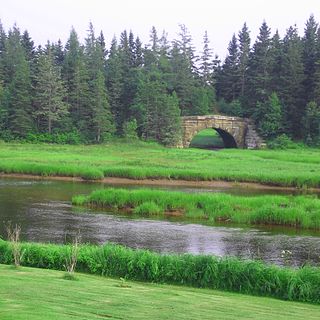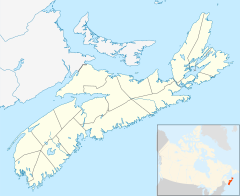
Chignecto Bay is an inlet of the Bay of Fundy located between the Canadian provinces of New Brunswick and Nova Scotia and separated from the waters of the Northumberland Strait by the Isthmus of Chignecto. It is a unit within the greater Gulf of Maine Watershed. Chignecto Bay forms the northeastern part of the Bay of Fundy which splits at Cape Chignecto and is delineated on the New Brunswick side by Martin Head. Chignecto Bay is a Ramsar site.
East Amherst is a Canadian rural community located in northwestern Cumberland County, Nova Scotia near the border with New Brunswick, located on Trunk 6, immediately east of the Town of Amherst's municipal boundary.
The Fundy Shore Ecotour is a former scenic drive and network of tourist destinations in the Canadian province of Nova Scotia and encircles several sub-basins of the Bay of Fundy, which contains the highest tidal range on the planet.

Route 302 is a collector road in the Canadian province of Nova Scotia.
Aulac is a Canadian community in Westmorland County, New Brunswick. As of January 1, 2023 it is part of the Municipality of Tantramar which consists of the former town of Sackville, Village of Dorchester, Pointe de Bute and other rural communities. It is located between the former college town of Sackville and the provincial border with Nova Scotia.

Cumberland Basin is an inlet and northeasternmost part of the Bay of Fundy, located on the border between the Canadian provinces of Nova Scotia and New Brunswick. It is the eastern branch of Chignecto Bay, which in turn is the western arm of the upper Bay of Fundy.
Springhill Junction is a rural community in central Cumberland County, Nova Scotia, Canada. It is approximately 4 kilometres (2.5 mi) northwest of Springhill, Nova Scotia.
Fort Lawrence is a Canadian rural community located on the Isthmus of Chignecto in Cumberland County, Nova Scotia, which is named after Fort Lawrence.
The River Hebert is a small tidal river that empties into the Cumberland Basin, and is contained completely within Cumberland County, Nova Scotia. According to estimates by the Province of Nova Scotia, there were 9,092 people resident within the Maccan/Kelley/Hebert watershed in 2011.

Athol is a very small community along Route 302 in the Canadian province of Nova Scotia. It is located between Amherst and Parrsboro. The community is named after John Murray, 4th Duke of Atholl.
The Maccan River is a small tidal river contained completely within Cumberland County, Nova Scotia. The river terminates at the confluence of River Hebert at Amherst Point, and empties into the Cumberland Basin. The river's tidal bore may be viewed from the Tidal Wetlands Park in Maccan. According to estimates by the Province of Nova Scotia, there are 9,092 people resident within the Maccan/Kelly/Hebert watershed in 2011.
Rufus Seaman Carter was a farmer and political figure in Nova Scotia, Canada. He represented Cumberland County in the Nova Scotia House of Assembly from 1911 to 1920 as a Liberal member.

Tidnish Bridge is a community in the Canadian province of Nova Scotia, located in Cumberland County on the interprovincial border with New Brunswick between Upper Tidnish, and Lower Tidnish on the Tidnish River. Tidnish Bridge is home to the Chignecto Ship Railway Keystone Bridge and would have been the Baie Verte terminus. Tidnish Dock Provincial Park is where the last piece of the project remained. The name Tidnish is of Mi'kmaqi origin, said to signify "A Paddle".
Amherst Point is a community in the Canadian province of Nova Scotia, located in Cumberland County.
Amherst Head is a community in the Canadian province of Nova Scotia, located in Cumberland County.
Amherst Shore is a small community in the Canadian province of Nova Scotia, located in Cumberland County.
Franklin Manor 22 is a Mi'kmaq reserve located in Cumberland County, Nova Scotia. It is administratively split between the Pictou Landing First Nation and the Paq'tnkek First Nation.

A township in Nova Scotia, Canada, was an early form of land division and local administration during British colonial settlement in the 18th century. They were created as a means of populating the colony with people loyal to British rule. They were typically rural or wilderness areas of around 100,000 acres (400 km2) that would eventually include several villages or towns. Some townships, but not all, returned a member to the General Assembly of Nova Scotia; others were represented by the members from the county. Townships became obsolete by 1879 by which time towns and counties had become incorporated.
The Fundy Shore Scenic Drive is a scenic drive in the Canadian province of Nova Scotia. It located along the northeastern portion of the Bay of Fundy, following the Chignecto Peninsula which separates Chignecto Bay and Minas Basin, an area which contains the highest tidal range on the planet.





